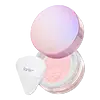What's inside
What's inside
 Key Ingredients
Key Ingredients

 Benefits
Benefits

 Concerns
Concerns

 Ingredients Side-by-side
Ingredients Side-by-side

Mica
Cosmetic ColorantSilica
AbrasiveTapioca Starch
Zea Mays Starch
AbsorbentAluminum Starch Octenylsuccinate
AbsorbentLauroyl Lysine
Skin ConditioningAlumina
AbrasiveBoron Nitride
AbsorbentKaolin
AbrasiveWater
Skin ConditioningBenzyl Alcohol
PerfumingCetyl Alcohol
EmollientPhenoxyethanol
PreservativePropanediol
SolventDecylene Glycol
Skin Conditioning1,2-Hexanediol
Skin ConditioningGlycerin
HumectantLonicera Japonica Flower Extract
Skin ConditioningOcimum Basilicum Extract
AntioxidantTrisodium Ethylenediamine Disuccinate
Linalool
PerfumingCitrus Paradisi Fruit Extract
Skin ConditioningVegetable Oil
Skin ConditioningUsnea Barbata Extract
Caprylhydroxamic Acid
Tocopherol
AntioxidantCI 77163
Cosmetic ColorantCI 77742
Cosmetic ColorantCI 77007
Cosmetic ColorantIron Oxides
CI 19140
Cosmetic ColorantMica, Silica, Tapioca Starch, Zea Mays Starch, Aluminum Starch Octenylsuccinate, Lauroyl Lysine, Alumina, Boron Nitride, Kaolin, Water, Benzyl Alcohol, Cetyl Alcohol, Phenoxyethanol, Propanediol, Decylene Glycol, 1,2-Hexanediol, Glycerin, Lonicera Japonica Flower Extract, Ocimum Basilicum Extract, Trisodium Ethylenediamine Disuccinate, Linalool, Citrus Paradisi Fruit Extract, Vegetable Oil, Usnea Barbata Extract, Caprylhydroxamic Acid, Tocopherol, CI 77163, CI 77742, CI 77007, Iron Oxides, CI 19140
Mica
Cosmetic ColorantTalc
AbrasiveMagnesium Carbonate
AbsorbentMagnesium Myristate
Nylon-12
Zea Mays Starch
AbsorbentJojoba Esters
EmollientBenzoic Acid
MaskingLauroyl Lysine
Skin ConditioningPolymethyl Methacrylate
Sodium Dehydroacetate
PreservativeCaprylic/Capric Triglyceride
MaskingGlycine Soja Oil
EmollientEthylhexyl Palmitate
EmollientTocopherol
AntioxidantIron Oxides
Ingredients Explained
These ingredients are found in both products.
Ingredients higher up in an ingredient list are typically present in a larger amount.
This ingredient comes from a fatty acid (lauric acid) and amino acid (lysine). It is used to add a silky feel to cosmetics.
According to a manufacturer, its fatty acid base leaves a silky feeling on the skin. It also has emollient properties because of this. Emollients help soften skin by preventing water from evaporating.
Lauroyl lysine is barely soluble in water.
Learn more about Lauroyl LysineMica is a naturally occurring mineral used to add shimmer and color in cosmetics. It can also help improve the texture of a product or give it an opaque, white/silver color.
Serecite is the name for very fine but ragged grains of mica.
This ingredient is often coated with metal oxides like titanium dioxide. Trace amounts of heavy metals may be found in mica, but these metals are not harmful in our personal products.
Mica has been used since prehistoric times throughout the world. Ancient Egyptian, Indian, Greek, Roman, Aztec, and Chinese civilizations have used mica.
Learn more about MicaTocopherol (also known as Vitamin E) is a common antioxidant used to help protect the skin from free-radicals and strengthen the skin barrier. It's also fat soluble - this means our skin is great at absorbing it.
Vitamin E also helps keep your natural skin lipids healthy. Your lipid skin barrier naturally consists of lipids, ceramides, and fatty acids. Vitamin E offers extra protection for your skin’s lipid barrier, keeping your skin healthy and nourished.
Another benefit is a bit of UV protection. Vitamin E helps reduce the damage caused by UVB rays. (It should not replace your sunscreen). Combining it with Vitamin C can decrease sunburned cells and hyperpigmentation after UV exposure.
You might have noticed Vitamin E + C often paired together. This is because it is great at stabilizing Vitamin C. Using the two together helps increase the effectiveness of both ingredients.
There are often claims that Vitamin E can reduce/prevent scarring, but these claims haven't been confirmed by scientific research.
Learn more about TocopherolZea Mays Starch is starch made from corn. You might know this as cornstarch . It is used to thicken a product. It can replace talc as an absorbent.
The pH of cornstarch is 5.92.
Cornstarch is a common food ingredient used to thicken soups or to make corn syrup.
Learn more about Zea Mays StarchThis ingredient is a combination of red, black, and yellow iron oxide pigments. This combination of colors is usually found in foundation, because it results in a "skin" color.